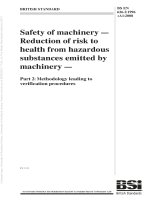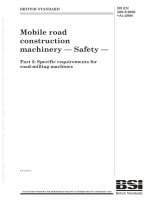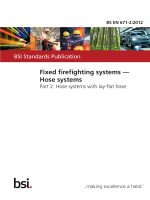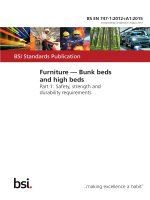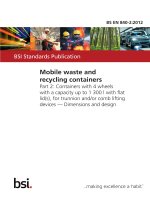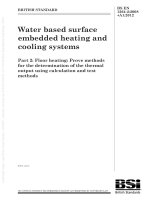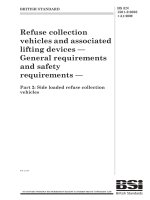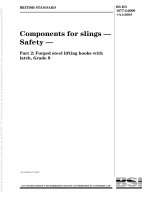Bsi bs en 00747 2 2012 + a1 2015
Bạn đang xem bản rút gọn của tài liệu. Xem và tải ngay bản đầy đủ của tài liệu tại đây (1.27 MB, 24 trang )
BS EN 747-2:2012+A1:2015
Incorporating
corrigendum
January 2013
BS EN
747-2:2012
BSI Standards Publication
Furniture — Bunk beds and
high beds
Part 2: Test methods
BS EN 747-2:2012+A1:2015
BRITISH STANDARD
National foreword
This British Standard is the UK implementation of
EN 747-2:2012+A1:2015. It supersedes BS EN 747-2:2012 which is
withdrawn.
The start and finish of text introduced or altered by amendment is
indicated in the text by tags. Tags indicating changes to CEN text
carry the number of the CEN amendment. For example, text altered
by CEN amendment A1 is indicated by. !" .
The UK participation in its preparation was entrusted by Technical
Committee FW/O, Furniture, to Subcommittee FW/0/2, Domestic and
Contract Furniture.
A list of organizations represented on this subcommittee can be
obtained on request to its secretary.
This publication does not purport to include all the necessary
provisions of a contract. Users are responsible for its correct
application.
© The British Standards Institution 2015. Published by BSI Standards
Limited 2015
ISBN 978 0 580 83806 4
ICS 97.140
Compliance with a British Standard cannot confer immunity from
legal obligations.
This British Standard was published under the authority of the
Standards Policy and Strategy Committee on 30 April 2012.
Amendments/corrigenda issued since publication
Date
31 January 2013
30 June 2015
Text affected
Implementation of CEN Correction Notice
29 August 2012: Subclause 4.2 paragraph 1,
the number of cones has been changed to six;
Subclause 5.5 paragraph 5, the word ‘and’ has
been changed to ‘or’
Implementation of CEN amendment A1:2015
EUROPEAN STANDARD
EN 747-2:2012+A1
NORME EUROPÉENNE
EUROPÄISCHE NORM
May 2015
ICS 97.140
Supersedes EN 747-2:2012
English Version
Furniture - Bunk beds and high beds - Part 2: Test methods
Meubles - Lits superposés et lits surélevés - Partie 2:
Méthodes d'essai
Möbel - Etagenbetten und Hochbetten - Teil 2:
Prüfverfahren
This European Standard was approved by CEN on 8 March 2012 and includes Amendment 1 approved by CEN on 16 April 2015.
CEN members are bound to comply with the CEN/CENELEC Internal Regulations which stipulate the conditions for giving this European
Standard the status of a national standard without any alteration. Up-to-date lists and bibliographical references concerning such national
standards may be obtained on application to the CEN-CENELEC Management Centre or to any CEN member.
This European Standard exists in three official versions (English, French, German). A version in any other language made by translation
under the responsibility of a CEN member into its own language and notified to the CEN-CENELEC Management Centre has the same
status as the official versions.
CEN members are the national standards bodies of Austria, Belgium, Bulgaria, Croatia, Cyprus, Czech Republic, Denmark, Estonia,
Finland, Former Yugoslav Republic of Macedonia, France, Germany, Greece, Hungary, Iceland, Ireland, Italy, Latvia, Lithuania,
Luxembourg, Malta, Netherlands, Norway, Poland, Portugal, Romania, Slovakia, Slovenia, Spain, Sweden, Switzerland, Turkey and United
Kingdom.
EUROPEAN COMMITTEE FOR STANDARDIZATION
COMITÉ EUROPÉEN DE NORMALISATION
EUROPÄISCHES KOMITEE FÜR NORMUNG
CEN-CENELEC Management Centre: Avenue Marnix 17, B-1000 Brussels
© 2015 CEN
All rights of exploitation in any form and by any means reserved
worldwide for CEN national Members.
Ref. No. EN 747-2:2012+A1:2015 E
BS EN 747-2:2012+A1:2015
EN 747-2:2012+A1:2015 (E)
Contents
Page
Foreword ..............................................................................................................................................................3
Introduction .........................................................................................................................................................4
1
Scope ......................................................................................................................................................5
2
Normative references ............................................................................................................................5
3
3.1
3.2
3.3
General test conditions .........................................................................................................................5
Preliminary preparation ........................................................................................................................5
Application of forces .............................................................................................................................6
Tolerances ..............................................................................................................................................6
4
4.1
4.2
4.3
4.3.1
4.3.2
4.3.3
4.4
4.5
4.6
4.7
4.8
4.9
4.10
Test equipment ......................................................................................................................................6
General ....................................................................................................................................................6
Measuring cones....................................................................................................................................6
Bed base impactor .................................................................................................................................7
Bed base impactor (see Figure 2) ........................................................................................................7
Springs ....................................................................................................................................................7
Striking surface ......................................................................................................................................8
Loading pads..........................................................................................................................................8
Test mattress..........................................................................................................................................8
Test mass ...............................................................................................................................................9
Stops .......................................................................................................................................................9
Floor surface ..........................................................................................................................................9
Tread impactor .......................................................................................................................................9
Template for V-shaped openings ...................................................................................................... 10
5
5.1
5.2
5.3
5.3.1
5.3.2
5.4
5.4.1
5.4.2
5.4.3
5.4.4
5.4.5
5.5
5.6
5.6.1
5.6.2
5.6.3
5.6.4
5.7
5.8
Test procedures .................................................................................................................................. 10
Inspection before testing ................................................................................................................... 10
Inspection of product ......................................................................................................................... 10
Measurements ..................................................................................................................................... 10
Holes, gaps and openings ................................................................................................................. 10
V and irregular shaped holes, gaps and openings ......................................................................... 11
Strength tests ...................................................................................................................................... 13
Positioning of the bed ........................................................................................................................ 13
Static load on safety barriers ............................................................................................................ 13
Upwards and downwards static load on bed base ......................................................................... 14
Impact test on bed base ..................................................................................................................... 14
Durability test on bed base ................................................................................................................ 15
Durability test of frame and fastenings ............................................................................................ 15
Ladders or other means of access ................................................................................................... 16
Vertical static load on treads ............................................................................................................. 16
Horizontal static loads on treads ...................................................................................................... 16
Durability of treads ............................................................................................................................. 17
Tread impact test ................................................................................................................................ 17
Stability test ......................................................................................................................................... 18
Fastening of the upper bed to the lower bed ................................................................................... 18
6
Test report ........................................................................................................................................... 18
BS EN 747-2:2012+A1:2015
EN 747-2:2012+A1:2015 (E)
Foreword
This document (EN 747-2:2012+A1:2015) has been prepared by Technical Committee CEN/TC 207
“Furniture”, the secretariat of which is held by UNI.
This European Standard shall be given the status of a national standard, either by publication of an identical
text or by endorsement, at the latest by November 2015, and conflicting national standards shall be withdrawn
at the latest by November 2015.
Attention is drawn to the possibility that some of the elements of this document may be the subject of patent
rights. CEN [and/or CENELEC] shall not be held responsible for identifying any or all such patent rights.
This document includes Amendment 1, approved by CEN on 2015-04-16.
The start and finish of text introduced or altered by amendment is indicated in the text by tags ! ".
This document supersedes !EN 747-2:2012".
!deleted text"
EN 747 is divided into the following parts:
—
EN 747-1, Furniture — Bunk beds and high beds — Part 1: Safety, strength and durability requirements;
—
EN 747-2, Furniture — Bunk beds and high beds — Part 2: Test methods.
According to the CEN-CENELEC Internal Regulations, the national standards organisations of the following
countries are bound to implement this European Standard: Austria, Belgium, Bulgaria, Croatia, Cyprus, Czech
Republic, Denmark, Estonia, Finland, Former Yugoslav Republic of Macedonia, France, Germany, Greece,
Hungary, Iceland, Ireland, Italy, Latvia, Lithuania, Luxembourg, Malta, Netherlands, Norway, Poland, Portugal,
Romania, Slovakia, Slovenia, Spain, Sweden, Switzerland, Turkey and the United Kingdom.
BS EN 747-2:2012+A1:2015
EN 747-2:2012+A1:2015 (E)
Introduction
This part of EN 747 describes a number of tests consisting of the application, to various parts of bunk beds
and high beds, of loads or forces applied by one adult occupant per bed during normal functional use. It also
deals with misuses that can be reasonably expected to occur.
The tests are designed to evaluate properties without regard for materials, design/construction or
manufacturing processes.
BS EN 747-2:2012+A1:2015
EN 747-2:2012+A1:2015 (E)
1
Scope
This European Standard specifies test methods for the safety, strength and durability of bunk beds and high
beds for domestic and non-domestic use. The loads and forces in the strength and durability tests apply to
beds with an internal length greater than 140 cm and a maximum bed base width of 120 cm.
The tests are designed to be applied to a bed that is fully assembled and ready for use.
The applicable safety requirements are given in EN 747-1.
2
Normative references
The following documents, in whole or in part, are normatively referenced in this document and are
indispensable for its application. For dated references, only the edition cited applies. For undated references,
the latest edition of the referenced document (including any amendments) applies.
!EN 747-1:2012+A1:2015", Furniture — Bunk beds and high beds — Part 1: Safety, strength and
durability requirements
EN ISO 2439:2008, Flexible cellular polymeric materials - Determination of hardness (indentation technique)
(ISO 2439:2008)
3
3.1
General test conditions
Preliminary preparation
For furniture that includes hygroscopic materials, at least one week in normal indoor conditions shall have
elapsed between manufacturing (or assembly) and testing.
For all other furniture, at least 48 hours in normal indoor conditions shall have elapsed prior to testing.
The sample shall be tested as delivered. If the sample is a knock-down type, it shall be assembled according
to the instructions supplied with it. If the instructions allow for different combinations, the most adverse
combination shall be used for each test.
Samples intended to be fastened together in pairs or attached to the structure of a building shall be tested as
single, free-standing samples unless the instructions specifically require attachment to another sample or the
building structure.
The test shall be carried out in indoor ambient conditions at a temperature between 15 °C and 25 °C. If, during
a test, the temperature falls outside of the range of 15 °C to 25 °C, the maximum and/or minimum temperature
shall be recorded in the test report.
Knock-down fittings shall be tightened before testing and shall not be re-tightened throughout the testing
procedures.
The tests shall be carried out on the same sample and following the order of the clauses of EN 747-1. If a test
cannot be carried out as specified in this standard, e.g. because a loading pad cannot be used for the
application of a force due to the design of the product, the test shall be carried out as closely as possible to
the specified procedure.
BS EN 747-2:2012+A1:2015
EN 747-2:2012+A1:2015 (E)
3.2
Application of forces
The test forces in durability and static load tests shall be applied sufficiently slowly to ensure that negligible
dynamic load is applied.
The forces in durability tests shall be applied sufficiently slowly to ensure that kinetic heating does not occur.
Unless otherwise specified, static loads shall be maintained for (10 ± 2) s. Unless otherwise specified,
durability loads shall be applied for (2 ± 1) s.
3.3
Tolerances
Unless otherwise stated, the following tolerances are applicable to the test equipment:
—
all forces shall have an accuracy of ± 5 % of the nominal force;
—
all masses shall have an accuracy of ± 1 % of the nominal mass;
—
all dimensions shall have an accuracy of ± 1 mm of the nominal dimension;
—
all angles shall have an accuracy of ± 2 ° of the nominal angle.
The tolerance for the positioning of loading pads shall be ± 5 mm.
The forces may be replaced by masses. The relationship of 10 N = 1 kg shall be used.
NOTE
For the purposes of uncertain measurements, test results are not considered to be adversely affected when
the above tolerances are met.
4
4.1
Test equipment
General
The test forces may, unless otherwise stated, be applied by any suitable device, as results only depend on
correctly applied forces and loads and not on the apparatus.
The equipment shall be capable of following the deformation of the unit/component during testing so that the
loads are always applied at specified points and in specified directions.
4.2
Measuring cones
Cones with an angle of (30 ± 1)° made of plastic or some other hard, smooth material (see Figure 1). There
shall be six cones with the diameters 5 mm, 7 mm, 12 mm, 25 mm, 60 mm and 75 mm.
The 5 mm, 7 mm, 25 mm and 75 mm cone diameters shall have tolerances of (0/-0,1) mm.
The 12 mm and 60 mm cone diameters shall have tolerances of (0/+0,1) mm.
BS EN 747-2:2012+A1:2015
EN 747-2:2012+A1:2015 (E)
Figure 1 — Examples of measuring cones
4.3
Bed base impactor
4.3.1
Bed base impactor (see Figure 2)
Approximately 200 mm in diameter, separated from the striking surface by helical compression springs and
free to move relative to it on a line perpendicular to the plane of the central area of the striking surface
(see Figure 2). The body and associated parts minus the springs shall have a mass of (17 ± 0,1) kg and the
whole apparatus, including mass, springs and striking surface, shall have a mass of (25 ± 0,1) kg.
4.3.2
Springs
Springs shall be such that the combined spring system has a nominal spring rate of (7 ± 2) N/mm and the total
friction resistance of the moving parts is less than 1 N. The spring system shall be compressed to an initial
load of (1 040 ± 5) N (measured statically), and the amount of spring compression movement available from
the initial compression point to the point where the springs become fully closed shall not be less than 60 mm.
Key
1
Connecting part of the lifting device which shall not restrain the free fall
2
Striking surface
Figure 2 — Bed base impactor
BS EN 747-2:2012+A1:2015
EN 747-2:2012+A1:2015 (E)
4.3.3
Striking surface
Rigid and circular object, 200 mm in diameter, the face of which has a convex spherical curvature of a
300 mm radius with a 12 mm front edge radius (see Figure 3).
4.4
Loading pads
4.4.1 Rigid and circular object, 200 mm in diameter, the face of which has a convex spherical curvature of
a 300 mm radius with a 12 mm front edge radius (see Figure 3).
Dimensions in millimetres
Figure 3 — Loading pad
4.4.2 Rigid and cylindrical object, 100 mm in diameter, having a flat, smooth, hard surface and rounded
edge with a radius of 12 mm.
4.5
Test mattress
3
Soft polyether foam sheet with a thickness of 100 mm, a bulk density of (30 ± 2) kg/m , an indentation
hardness index of (170 ± 20) N in accordance with A 40 of EN ISO 2439:2008, and with dimensions more or
less the same as those of the bed base tested. The test mattress may have a cover, in which case it shall
have the following characteristics:
—
composition: pure cotton;
—
weave in plain: 1/1;
—
mass per unit area: 100 g/m² to 120 g/m²;
—
warp and weft: 20 threads/cm to 30 threads/cm;
—
finishing: washed, no finishing agents;
—
cover make up: tight fit, but with no restrictions on the foam.
BS EN 747-2:2012+A1:2015
EN 747-2:2012+A1:2015 (E)
The same part of the test mattress shall not be re-used within 30 min and the mattress shall be replaced if
damaged, or after 20 tests.
4.6
Test mass
A mass of 75 kg distributed over an area of approximately 300 mm x 300 mm or a diameter of approximately
340 mm.
4.7
Stops
Stops, to prevent the bed from sliding but not tilting, no higher than 12 mm, except in cases where the design
of the bed necessitates the use of higher stops, in which case the lowest that will prevent the bed from sliding
shall be used.
4.8
Floor surface
Horizontal, rigid, flat and smooth.
4.9
Tread impactor
Apparatus as shown in Figure 4.
Dimensions in millimetres
Key
1
HTS (High Tensile Steel) tube
Outer diameter: 25
Wall thickness: 2
Approximate mass: 1,6 kg
2
Impact pad 100 x 100 x 6 steel plate fitting
Total mass: 0,5 kg
Figure 4 — Tread impactor
BS EN 747-2:2012+A1:2015
EN 747-2:2012+A1:2015 (E)
!
4.10 Template for V-shaped openings
The template for V and irregular shaped openings shall be made from plastics or other hard, smooth material
with the dimensions given in Figure 5. The tolerance for the angles shall be ± 1°.
Key
1
B portion
2
A portion
Figure 5 — V and irregular shaped openings template"
5
Test procedures
5.1
Inspection before testing
Prior to the test, visually inspect the bed for defects.
5.2
Inspection of product
Inspect the sample to determine whether exposed edges, screws, bolts, zips and other fittings are rounded or
chamfered and free of burr and sharp edges.
!
5.3
5.3.1
Measurements
Holes, gaps and openings
Check all holes, gaps and openings according to EN 747-1:2012+A1:2015 of this standard as follows:
BS EN 747-2:2012+A1:2015
EN 747-2:2012+A1:2015 (E)
Table 1 — Cones and forces
EN 747-1:2012+A1:2015, clause
Force
Cones
4.1.2, 4.1.4
With force
7 mm
4.1.4
With force
5 mm and 75 mm
4.1.2, 4.1.3
Without force
60 mm
4.1.2, 4.1.5
With force
25 mm and 75 mm
With force
7 mm, 25 mm and 75 mm
Without force
12 mm and 60 mm
Where required, press the 5 mm and 7 mm cones into the gap with a force of 30 N and the 25 mm and 75 mm
cones with a force of 100 N. Record whether or not the cone passes through the gap.
All other gaps shall be measured with the appropriate equipment.
5.3.2
V and irregular shaped holes, gaps and openings
Check whether portion ‘B’ of the template (4.10) enters the opening to the full thickness of the template (45
mm), as shown in Figure 6 or Figure 7 as appropriate.
If the template (4.10) can be inserted to a depth greater than the thickness of the template (45 mm), apply the
‘A’ portion of the template, so that its centre line is in line with the centre line of the opening.
Ensure that the plane of the template is parallel and applied in line with the opening, as shown in Figure 8.
Insert the template along the centre line of the opening until its motion is arrested by contact with the
boundaries of the opening. Check whether the apex of portion A of the template contacts the base of the
opening.
Key
1 and 2 do not enter to the full thickness of the template
3 and 4 enter more than the full thickness of the template
Figure 6 — Method of insertion of portion B
BS EN 747-2:2012+A1:2015
EN 747-2:2012+A1:2015 (E)
Key
1
does not enter
2
enters
Figure 7 — Method of insertion of portion B
BS EN 747-2:2012+A1:2015
EN 747-2:2012+A1:2015 (E)
Key
1
contacts the base of the opening
2
does not contact the base of the opening
Figure 8 — Method of insertion of portion A"
5.4
Strength tests
5.4.1
Positioning of the bed
If the sample tends to move during the tests specified in 5.4.2, 5.4.3, 5.4.4 and 5.4.5, the sample shall be
positioned on the floor with all legs against stops (see 4.7).
5.4.2
Static load on safety barriers
For each test, place the test mass (see 4.6) on the upper bed base where it is most likely to prevent
overturning. If this mass is not sufficient to prevent overturning, additional mass(es) shall be placed on the bed
until overturning is prevented. The additional mass(es) may be placed on any suitable part of the bed.
Apply the following forces separately:
—
vertical upwards force of 200 N;
—
horizontal force outwards of 500 N;
BS EN 747-2:2012+A1:2015
EN 747-2:2012+A1:2015 (E)
—
horizontal force inwards of 500 N.
The forces shall be applied to the centre and to one end of the top safety barrier using the loading pad (see
4.4.2). The loading point shall be 50 mm below the top edge of the structure at each position.
When the construction or fastening of the top safety barrier differs between ends, both ends shall be tested.
Apply the forces 10 times, each time for 30 s, in each position.
Apply a vertical downwards force of 1 000 N to the top safety barrier. Apply the force 10 times for 30 s each
time. The loading point shall be at the top of the safety barrier, 250 mm from the intersection point of the
centre lines of the adjacent side and end members.
Repeat the test on each top safety barrier.
Where the construction or fastening of other elements of the safety barrier differs from the top safety barrier,
apply the forces at the point most likely to cause failure.
5.4.3
Upwards and downwards static load on bed base
Place the test mattress (see 4.5) on the bed base.
Apply a vertical force of 1 200 N downward using the loading pad (see 4.4.1) as shown in Figure 3. Apply the
load 10 times for 30 s at any point on the bed base where failure is considered likely to occur. !This test
shall be carried out on both the upper and lower bed if the constructions differ."
Apply a vertical force of 500 N upwards using the loading pad (see 4.4.1) as shown in Figure 3. Apply the load
4 times for 30 s at any point on the bed base where failure is considered likely to occur. If the bed tends to lift
from the floor during this test, it shall be prevented from lifting without loading the bed base.
5.4.4
Impact test on bed base
Place the test mattress (see 4.5) on the bed base.
The impacts shall be positioned as follows !(see Figure 9)":
a)
centre of the bed base (point a);
b)
one third of the longitudinal axis from the middle (point b);
c)
point opposite of b (point c);
d)
point of 200 mm measured from the adjacent edges (point d);
e)
any place where the bed base appears weakest.
Drop the impactor (see 4.3) 10 times from a distance of 180 mm above the bed base on to the test mattress at
each of the selected positions of impact !(see Figure 9)". The impactor shall be permitted to fall freely but
may be guided by a guide rail.
This test shall be carried out on both the upper and lower bed if the constructions differ.
BS EN 747-2:2012+A1:2015
EN 747-2:2012+A1:2015 (E)
Dimensions in millimetres
Key
L
Half internal length
!Figure 9" — Bed base impact positions
5.4.5
Durability test on bed base
Place the test mattress (see 4.5) on the bed base.
Apply a vertical force of 1 000 N downwards using the loading pad (see 4.4.1). Apply the load 10 000 times at
a rate of not more than 15 loads/min. The loading positions shall be each of the two positions shown in
!Figure 10" and at one position where failure is most likely to occur. !This test shall be carried out on
both the upper and lower bed if the constructions differ."
Dimensions in millimetres
!Figure 10" — Durability of bed base loading positions
5.5
Durability test of frame and fastenings
This test does not apply to bunk beds and high beds that are intended to be fixed to the structure of the
building.
BS EN 747-2:2012+A1:2015
EN 747-2:2012+A1:2015 (E)
Restrain the sample with stops (see 4.7) in all directions at the bottom of each corner.
Position the test mass (see 4.6) at the centre of the base of the upper bed.
The loading points shall be at the height of the upper bed base, 50 mm from the intersection point of the
centre lines of the adjacent side and end members.
Apply by means of the loading pad (see 4.4.2) alternating forces of 300 N for 10 000 cycles !(see Figure
11)" at each point in the order A-B-C-D at a maximum rate of 6 cycles/min or A-B followed by C-D at a
maximum rate of 12 cycles/min.
!Figure 11" — Durability of frame — Application of load and forces
5.6
5.6.1
Ladders or other means of access
Vertical static load on treads
Position the sample on the floor with the legs against stops (see 4.7) but without restraining the upright
components of the means of access.
Apply by means of the loading pad (see 4.4.2) a 1 200 N vertical downwards force to the tread most likely to
cause failure. The load application shall be at the mid-point of the tread. The load shall be applied 10 times for
30 s each time.
5.6.2
Horizontal static loads on treads
Apply a 1 000 N load vertically downward to the centre of the mid-tread, or in the case of an even number,
500 N to each of the two mid-treads together with horizontal static loads of 500 N, one after the other, for a
load duration of 60 s in the order shown in !Figure 12".
The loads shall be applied to the side members of the ladder at the height of the top tread, or, if this is not
possible, just above the top tread (the uppermost horizontal ladder component).
BS EN 747-2:2012+A1:2015
EN 747-2:2012+A1:2015 (E)
!Figure 12" — Vertical and horizontal static loads on treads
5.6.3
Durability of treads
Using the loading pad (see 4.4.2) apply a vertical load of 1 000 N to the tread nearest the centre of the ladder
with the ladder in its intended position, for a total of 10 000 cycles at a rate not more than 24 loads per minute.
5.6.4
Tread impact test
Set the ladder or means of access in its position of use.
Position the tread impactor (see 4.9) on the longitudinal centreline of the tread and as close to one side as
possible, so that it can be dropped freely onto the tread. Apply the impact test as illustrated in !Figure 13"
with a drop height of 150 mm. The tread impactor shall not be allowed to bounce.
Carry out the test 10 times. Repeat the test at the middle of the tread.
Test the top and bottom treads as well as the most central one.
BS EN 747-2:2012+A1:2015
EN 747-2:2012+A1:2015 (E)
Dimensions in millimetres
!Figure 13" — Tread impact test
5.7
Stability test
This test does not apply to bunk beds and high beds that are intended to be fixed to the structure of the
building.
The stability test shall be carried out without mattress(es).
Position the sample on the floor with the legs against stops (see 4.7). The tilting tendencies shall not be
restrained.
Apply by a horizontal force of 120 N at those points most likely to cause overturning.
5.8
Fastening of the upper bed to the lower bed
Apply an upward vertical static force of 500 N for 30 s at any position most likely to cause the beds to
separate. The load duration shall be 30 s.
If the lower bed tends to lift from the floor during this test, place a load on the lower bed sufficiently heavy to
prevent it from lifting.
6
Test report
The test report shall include at least the following information:
a)
reference to this part of EN 747;
b)
unit tested (relevant data);
BS EN 747-2:2012+A1:2015
EN 747-2:2012+A1:2015 (E)
c)
description of the delivery condition of the unit;
d)
test results according to 5.1 to 5.8;
e)
compliance with requirements according to EN 747-1;
f)
name and address of the test facility;
g)
date of test.
This page deliberately set blank
This page deliberately left blank
NO COPYING WITHOUT BSI PERMISSION EXCEPT AS PERMITTED BY COPYRIGHT LAW
British Standards Institution (BSI)
BSI is the national body responsible for preparing British Standards and other
standards-related publications, information and services.
BSI is incorporated by Royal Charter. British Standards and other standardization
products are published by BSI Standards Limited.
About us
Revisions
We bring together business, industry, government, consumers, innovators
and others to shape their combined experience and expertise into standards
-based solutions.
Our British Standards and other publications are updated by amendment or revision.
The knowledge embodied in our standards has been carefully assembled in
a dependable format and refined through our open consultation process.
Organizations of all sizes and across all sectors choose standards to help
them achieve their goals.
Information on standards
We can provide you with the knowledge that your organization needs
to succeed. Find out more about British Standards by visiting our website at
bsigroup.com/standards or contacting our Customer Services team or
Knowledge Centre.
Buying standards
You can buy and download PDF versions of BSI publications, including British
and adopted European and international standards, through our website at
bsigroup.com/shop, where hard copies can also be purchased.
If you need international and foreign standards from other Standards Development
Organizations, hard copies can be ordered from our Customer Services team.
Subscriptions
Our range of subscription services are designed to make using standards
easier for you. For further information on our subscription products go to
bsigroup.com/subscriptions.
With British Standards Online (BSOL) you’ll have instant access to over 55,000
British and adopted European and international standards from your desktop.
It’s available 24/7 and is refreshed daily so you’ll always be up to date.
You can keep in touch with standards developments and receive substantial
discounts on the purchase price of standards, both in single copy and subscription
format, by becoming a BSI Subscribing Member.
PLUS is an updating service exclusive to BSI Subscribing Members. You will
automatically receive the latest hard copy of your standards when they’re
revised or replaced.
To find out more about becoming a BSI Subscribing Member and the benefits
of membership, please visit bsigroup.com/shop.
With a Multi-User Network Licence (MUNL) you are able to host standards
publications on your intranet. Licences can cover as few or as many users as you
wish. With updates supplied as soon as they’re available, you can be sure your
documentation is current. For further information, email
BSI Group Headquarters
389 Chiswick High Road London W4 4AL UK
We continually improve the quality of our products and services to benefit your
business. If you find an inaccuracy or ambiguity within a British Standard or other
BSI publication please inform the Knowledge Centre.
Copyright
All the data, software and documentation set out in all British Standards and
other BSI publications are the property of and copyrighted by BSI, or some person
or entity that owns copyright in the information used (such as the international
standardization bodies) and has formally licensed such information to BSI for
commercial publication and use. Except as permitted under the Copyright, Designs
and Patents Act 1988 no extract may be reproduced, stored in a retrieval system
or transmitted in any form or by any means – electronic, photocopying, recording
or otherwise – without prior written permission from BSI. Details and advice can
be obtained from the Copyright & Licensing Department.
Useful Contacts:
Customer Services
Tel: +44 845 086 9001
Email (orders):
Email (enquiries):
Subscriptions
Tel: +44 845 086 9001
Email:
Knowledge Centre
Tel: +44 20 8996 7004
Email:
Copyright & Licensing
Tel: +44 20 8996 7070
Email:
